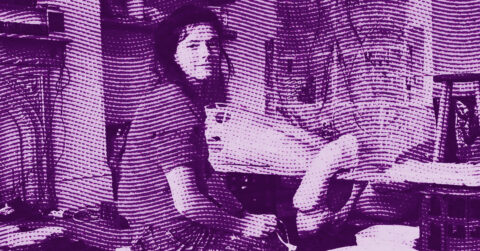Listen to me carefully, you bunch of snobs. Art is not always what you think it is. Take Mayuka Yamamoto, this Japanese artist born in 1964 in Okayama, who paints children with wide-open eyes wearing animal costumes. You might think these are simply cute and harmless images meant to be hung in children’s rooms to help them fall asleep. But you would be wrong, terribly wrong.
Since 2002, the year she began painting her first “animal boys” after the birth of her daughter, Yamamoto plunges us into an ambiguous universe where innocence and anxiety shamelessly coexist. Her canvases, executed with impeccable oil technique, show childlike faces with empty gazes, as if these little beings were prisoners of a reality they do not understand. The animal costumes covering them are not mere disguises; they have become their second skin, a protective armor against a threatening outside world.
Looking closely at these works, one perceives an atmosphere charged with palpable tension. These animal-children stare at us with their large eyes, in an attitude of apparent calm that hides deep anxiety. Yamamoto’s genius lies in her ability to create a subtle unease through apparently innocent scenes. The contrast between pastel tones, the childlike charm of the characters, and the strangeness of their situation destabilizes us. We face an unfinished metamorphosis, where human and animal blend into a hybrid creature, frozen in a troubling in-between.
What distinguishes Yamamoto in the contemporary Japanese art scene is her refusal to fully embrace the kawaii movement, this aesthetic of cuteness that has invaded Japanese popular culture. Although her works may appear at first glance to belong to it, they distance themselves by their ambiguous and melancholic character. Her animal-children are not joyful mascots; they are silent witnesses to a fading childhood, a lost innocence.
The influence of the Palermo catacombs on Yamamoto’s work is interesting. During a visit that deeply marked her, she was struck by the sight of child mummies lined up in their finest clothes, remnants of parental love that transcends death. “I remember initially feeling that I was looking for something, but I didn’t know what,” she confided. “They are just there, standing, in their dresses. The space was filled with mothers’ love for their children” [1]. This encounter with these little bodies frozen in eternity imprinted an indelible image on her mind that nourished her artistic work.
The children painted by Yamamoto are, like these mummies, in a state of temporal suspension. They do not run, play, or laugh. They stand still, sitting or standing, in static postures that evoke these small bodies preserved in the catacombs. The soft and faded palette she uses reinforces this impression of stopped time, as if the dust of centuries had settled on these enigmatic figures.
This fascination with preserving the child’s body refers us back to the reflections of anthropologist Philippe Ariès on the evolution of the concept of childhood in Western societies. In his book “L’Enfant et la vie familiale sous l’Ancien Régime”, Ariès demonstrates how the child, long considered merely a miniature adult, gradually became a full-fledged subject in its own right, with its own specificities and intrinsic value [2]. Yamamoto’s paintings seem to question this social construction of childhood by depicting beings who are neither completely children nor completely animals, as if their identity were in constant negotiation.
Yamamoto’s art explores the blurred areas of childhood consciousness, those territories where archaic fears and hidden desires intermingle. In this, her work echoes Melanie Klein’s psychoanalytic theories on the psychic development of the child. Klein highlighted the importance of primitive fantasies in personality construction, showing how the child projects its internal conflicts onto the external world [3]. Yamamoto’s hybrid creatures can be seen as visual manifestations of these original fantasies, where human and animal blend in an effort to apprehend a complex and often threatening world.
The melancholy permeating Yamamoto’s work is reminiscent of that of Yoshitomo NARA, another major figure in contemporary Japanese art. Both share a childhood marked by absence: parents too busy working, solitude in a Japan undergoing rapid economic transformation. But where NARA expresses his rebellion through characters with sometimes aggressive expressions, Yamamoto opts for silent resignation, a form of withdrawal from the world. Her child-animals seem to have accepted their hybrid condition as a means of survival in an incomprehensible adult universe.
There is something deeply Japanese in this acceptance of the in-between, this ability to inhabit a liminal space. Japanese culture, nourished by Shintoism and Buddhism, has always accorded an important place to beings of the in-between world, creatures who are neither fully human nor fully animal or divine. The yokai, these spirits and monsters of Japanese folklore, populate an imagination where the borders between realms are porous. Yamamoto situates herself in this tradition while updating it through the prism of contemporary sensibility.
What makes Yamamoto’s work so poignant is the way it appeals to our own nostalgia for childhood. We recognize in these hybrid figures our own memories of a time when the boundaries between reality and imagination were blurred, when we could become, for the duration of a game, the animal we carried within us. “I think the main reason I started drawing images of children is that I remembered my own childhood through my experience of childcare,” she explains. “I think it reminds me of my feelings at the time, like being afraid and wanting to be protected by something warm and fluffy” [4].
This quest for protection, this desire to snuggle into the warmth of an imaginary fur, resonates in each of us. The animal costumes worn by her characters are like security blankets, bulwarks against the aggressions of the outside world. They evoke those comfort objects children clutch to reassure themselves, transitional objects theorized by Winnicott, which enable the negotiation of the passage between the internal world and the external world.
Yamamoto’s commercial success is undeniable. Her works are snapped up at high prices in Asian auction houses, collected by art enthusiasts from around the world, including Hong Kong actor Tony Leung. Does this mean that her art has become a mere commodity, a product tailored to satisfy the tastes of a wealthy elite seeking easy emotions? I do not believe so. Despite the immediate allure of her images, their power to disturb remains intact. They continue to haunt us long after we have looked away.
Yamamoto’s painting technique is particularly interesting. Initially trained in engraving at the Musashino Art University in Tokyo, she developed a style where precise contours are juxtaposed with surfaces in soft and vaporous hues. Her working method, born from the need to reconcile artistic creation with motherhood, is fascinating. She begins by painting on small canvases that she can easily hold, like “a small child,” then reproduces her compositions on larger formats. This approach, dictated by practical constraints, has become her artistic signature.
The neutral backgrounds on which her characters stand out reinforce their isolation, their existential solitude. These child-animals float in an indeterminate space, outside time and place, as if suspended in their own inner universe. Sometimes, a minimal decorative element, a stool or a toy, anchors the scene in tangible reality, but these objects themselves seem to belong to a dreamlike world.
Yamamoto’s color palette favors pastel tones, pale blues, faded pinks, beiges, and slightly creamy whites. These colors evoke both the innocence of childhood and the fragility of fading memory. They create an ethereal atmosphere, as if these scenes reach us through the filter of memory. This aesthetic of delicacy contrasts with the underlying emotional charge, creating a tension that lies at the heart of the aesthetic experience the artist offers us.
The gaze of Yamamoto’s child-animals is undoubtedly the most striking element of her paintings. These wide-open eyes, fixed on the viewer or lost in inner contemplation, are the true nerve centers of her compositions. They question us, challenge us, perhaps implore us. Their paradoxical expressiveness, both intense and indecipherable, creates a mirror effect where we project our own emotions, our own childhood memories.
Yamamoto’s work confronts us with our own contradictions regarding childhood. We idealize this period as a golden age of innocence and freedom, while knowing it is also traversed by anxieties and night terrors. We want to protect children while recognizing that overprotection can be suffocating. Yamamoto’s hybrid creatures embody these paradoxes: their animal costumes are both shelters and prisons, expressions of their imagination and marks of their alienation.
What makes Mayuka Yamamoto’s art powerful is her ability to create a bridge between the subjective experience of childhood and universal questions about identity, vulnerability, and the passage of time. Her child-animals are visual metaphors of our human condition, caught between nature and culture, between instinct and reason. They remind us that we all carry within us a lost child seeking their place in a world too big, too complex, sometimes too frightening.
In contemporary Japan marked by an aging population and declining birth rates, where children have become rare and precious beings, Yamamoto’s paintings acquire a particular resonance. They seem to tell us that childhood has become a disappearing territory, a mental and emotional space that we must preserve, not by embalming it like those little bodies in the catacombs of Palermo, but by recognizing its complexity and fragility.
So next time you see a painting by Mayuka Yamamoto in a gallery, don’t just admire its seductive surface. Dive into those child-animal gazes, let yourself be drawn in by their familiar strangeness. Perhaps you will find a fragment of your own childhood there, that suspended time when everything was possible, when the world was both wonderful and terrifying. Because this is the true power of art: to reconnect us to what we have lost without knowing it.
- Interview of Mayuka Yamamoto by Morgan Laurens for NotRealArt, “The Enigmatic ‘Animal Boys’ of Painter Mayuka Yamamoto”, 2022.
- Ariès, Philippe. “Childhood and Family Life under the Old Regime”, Éditions du Seuil, Paris, 1960.
- Klein, Melanie. “The Psychoanalysis of Children”, Presses Universitaires de France, Paris, 1959.
- Declaration of Mayuka Yamamoto during the exhibition “Menagerie” at GR Gallery, New York, 2023.
















